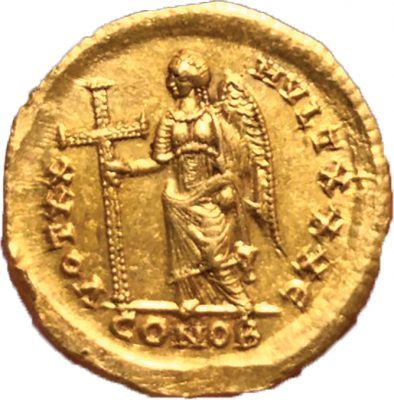×


We have detected your country as:
Please click here to go to the USA website or select another country from the dropdown list.
 Four high school students from Kibbutz Yifat in the Jezreel Valley spotted a gold coin glinting in the grass as they walked along the banks of the Zippori stream in the Galilee, adjacent to the Sanhedrin Trail (a 70-kilometer [43.5 mi] hiking trail that runs from Tiberias to Beit She’arim).
Four high school students from Kibbutz Yifat in the Jezreel Valley spotted a gold coin glinting in the grass as they walked along the banks of the Zippori stream in the Galilee, adjacent to the Sanhedrin Trail (a 70-kilometer [43.5 mi] hiking trail that runs from Tiberias to Beit She’arim).
After examining the coin, IAA [Israel Antiquities Authority] numismatic expert Dr. Gabriela Bijovsky said, “The gold coin is a solidus—a Roman coin of nearly solid gold, minted by the emperor Theodosius II in Constantinople (Istanbul) around [AD] 420–423. Similar coins are known from the Eastern Byzantine Empire, but this is the first of its type discovered in Israel. One side depicts the image of the emperor and the other shows the image of the Goddess Victory holding the Staff of the Cross.”
Theodosius II was one of the most influential emperors of the Byzantine Empire, compiling an Imperial Code of Laws, designated the “Codex Theodosius.”
According to Yair Amitzur, IAA chief archaeologist of the Sanhedrin Trail, “The emperor Theodosius II abolished the post of the nasi [prince], the head of the Sanhedrin Council, and decreed that the Jews’ financial contributions to the Sanhedrin be transferred to the Imperial Treasury. The Sanhedrin Trail…tells the story of the Jewish leadership in the Galilee at the time of the Mishnah (first written recording of Jewish tradition) and the Talmud (rabbinic commentary on Jewish tradition and the Hebrew Scriptures) in the Roman and Byzantine periods. It is symbolic that the gold coin discovered adjacent to the Sanhedrin Trail reflects the period of dramatic events when the Sanhedrin ceased to function in the Galilee, and the center of Jewish life transferred from the Galilee to Babylon.”
Source: Excerpt from an article by Edgar Asher, Ashernet
All logos and trademarks in this site are property of their respective owner. All other materials are property of Bridges for Peace. Copyright © 2025.
Website Site Design by J-Town Internet Services Ltd. - Based in Jerusalem and Serving the World.